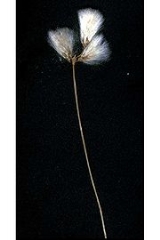
Eriophorum gracile
Encyclopedia
Eriophorum gracile is a species of flowering plant in the sedge family, Cyperaceae
. It is known by the common name slender cottonsedge, or slender cottongrass. Eriophorum gracile is a plant with circumboreal
distribution, extending south into mountain ranges of the Northern Hemisphere. It grows in wet areas such as bog
s.
Eriophorum gracile is a thin, tall perennial herb with a slender, rounded, solid, mostly naked stem reaching 30 to 60 centimeters in height. It produces a fluffy inflorescence
atop its stem with a wispy, cottony white flower. The plants grow in colonies, often spreading vegetatively
by rhizome
.
Cyperaceae
Cyperaceae are a family of monocotyledonous graminoid flowering plants known as sedges, which superficially resemble grasses or rushes. The family is large, with some 5,500 species described in about 109 genera. These species are widely distributed, with the centers of diversity for the group...
. It is known by the common name slender cottonsedge, or slender cottongrass. Eriophorum gracile is a plant with circumboreal
Circumboreal Region
The Circumboreal Region is a floristic region within the Holarctic Kingdom in Eurasia and North America, as delineated by such geobotanists as Josias Braun-Blanquet and Armen Takhtajan....
distribution, extending south into mountain ranges of the Northern Hemisphere. It grows in wet areas such as bog
Bog
A bog, quagmire or mire is a wetland that accumulates acidic peat, a deposit of dead plant material—often mosses or, in Arctic climates, lichens....
s.
Eriophorum gracile is a thin, tall perennial herb with a slender, rounded, solid, mostly naked stem reaching 30 to 60 centimeters in height. It produces a fluffy inflorescence
Inflorescence
An inflorescence is a group or cluster of flowers arranged on a stem that is composed of a main branch or a complicated arrangement of branches. Strictly, it is the part of the shoot of seed plants where flowers are formed and which is accordingly modified...
atop its stem with a wispy, cottony white flower. The plants grow in colonies, often spreading vegetatively
Vegetative reproduction
Vegetative reproduction is a form of asexual reproduction in plants. It is a process by which new individuals arise without production of seeds or spores...
by rhizome
Rhizome
In botany and dendrology, a rhizome is a characteristically horizontal stem of a plant that is usually found underground, often sending out roots and shoots from its nodes...
.

